Chitrakote Waterfall: The Niagara of India in Incredible Bastar you should visit in 2025
Tucked deep in the lush wilderness of Chhattisgarh’s Bastar district, Chitrakote Waterfall (also spelled Chitrakoot) is one of India’s best-kept secrets. Often hailed as the Niagara Falls of India, this magnificent horseshoe-shaped cascade on the Indravati River is not just a sight to behold but a complete experience—where nature, culture, and adventure come together in perfect harmony.
Chitrakote Waterfall is located about 38 kilometers from Jagdalpur, the district headquarters of Bastar. Plunging from a height of approximately 30 meters, it is the widest waterfall in India, stretching up to 300 meters during the monsoon. What makes Chitrakote Waterfall truly special is how dramatically it transforms with each passing season. In the summer months, the waterfall narrows into gentle ribbons of water, revealing the rugged cliffs beneath. It’s a time when the area is quieter, perfect for contemplative travelers and photographers who appreciate the bare bones of nature.
As the monsoon arrives, Chitrakote Waterfall undergoes a spectacular transformation. The river swells with rain, and the fall expands in both width and power, pouring down in massive torrents that create a deafening roar and clouds of mist that veil the surroundings. Rainbows frequently shimmer in the misty sunlight, making it a paradise for nature lovers. Come winter and post-monsoon, the waterfall retains its grandeur but becomes gentler, more composed. The flow is strong yet elegant, and the surroundings burst with fresh greenery and a peaceful ambience. This period, from October to February, is ideal for most visitors as the weather is pleasant and the waterfall is still at its vibrant best.
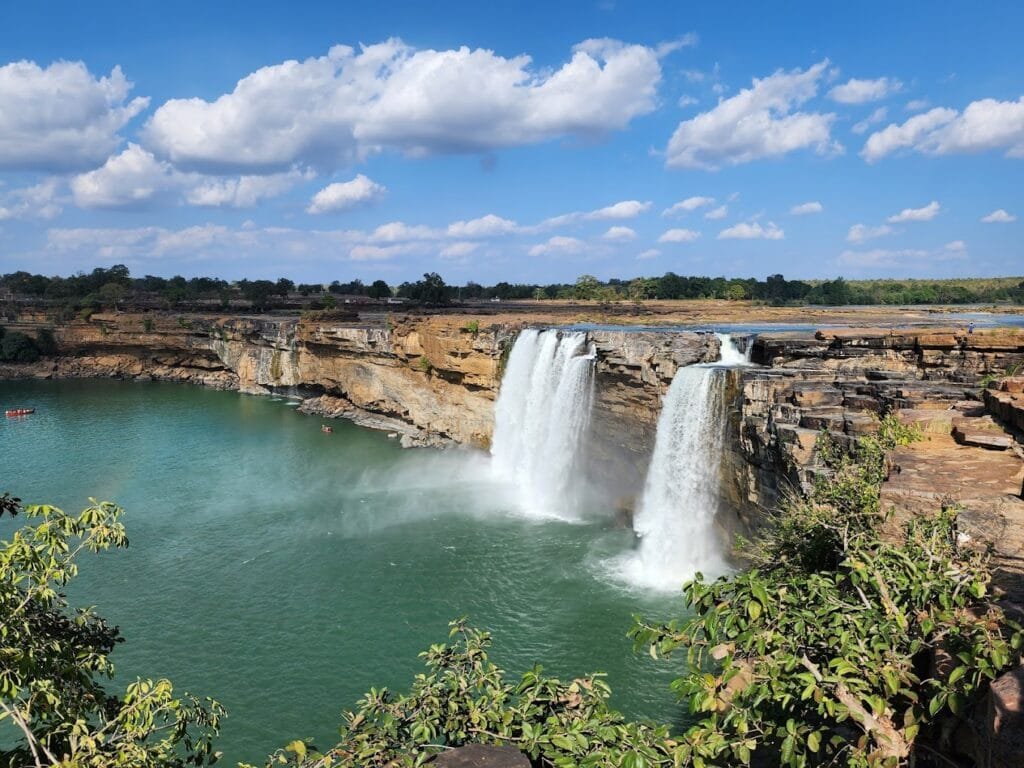
The Majestic Chitrakote Waterfall: Seasonal Spectacle
Location
- District: Bastar, Chhattisgarh
- Distance from Jagdalpur: 38 km
- Height: 30 meters (98 feet)
- Width: Up to 300 meters in monsoon
Seasonal Beauty of Chitrakote Waterfall
Chitrakote Waterfall is unique because its appearance and ambiance change dramatically with the seasons. During summer, it flows gently, revealing rocky formations. Monsoon transforms it into a roaring, wide cascade with misty rainbows, showcasing its full glory. In winter, it retains a strong yet serene flow, surrounded by lush greenery and pleasant weather, making each season a distinct and unforgettable experience:
Summer (March – June)
- The water level drops significantly.
- The waterfall becomes a narrow stream, falling gently over the rocky cliffs.
- Ideal for visitors who enjoy a quiet, less-crowded atmosphere.
- Rock formations and the cliff base become more visible, making it great for photography and picnics.
Monsoon (July – September)
- This is when Chitrakote Waterfall becomes truly majestic.
- The Indravati River swells with rainwater and spreads wide over the horseshoe-shaped cliff, creating thunderous roars and massive sprays.
- The fall is at its widest, often compared to Niagara Falls.
- Rainbows are commonly seen due to the mist and sunlight—perfect for photography lovers.
- Best time for adventure and dramatic visuals, though boating may be restricted due to strong currents.
Post-Monsoon & Winter (October – February)
- The water flow remains strong but is calmer than during peak monsoon.
- The weather is pleasant, and the surrounding forest is lush and green.
- Ideal time for boating, camping, and sightseeing.
- The waterfall appears golden during sunrise and sunset—creating a magical visual effect.
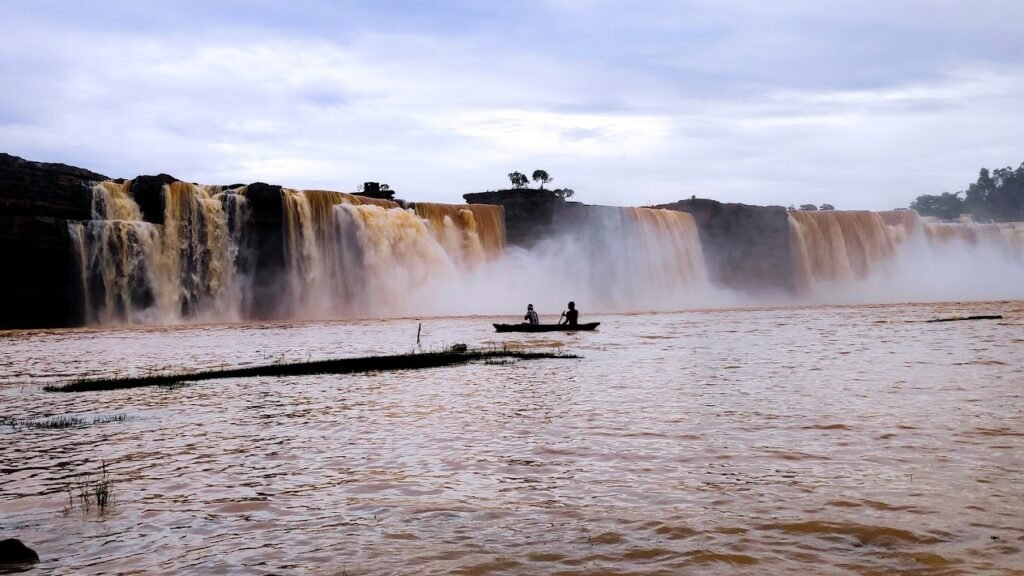
Boating in the Chitrakote Waterfall: A Close Encounter with Power
One of the most thrilling experiences at Chitrakote Waterfall is boating in the Indravati River, close to the plunge point of the waterfall.
- When available (post-monsoon and winter), local boatmen take you close to the falls, offering a dramatic view from below.
- The ride is serene at first, as you float through calm waters, but as you approach the falls, the sound of thundering water and rising mist give an adrenaline rush.
- These boat rides offer an intimate connection with the falls, far beyond what any viewpoint can provide.
- Life jackets are usually provided for safety.
- Best times: October to February.
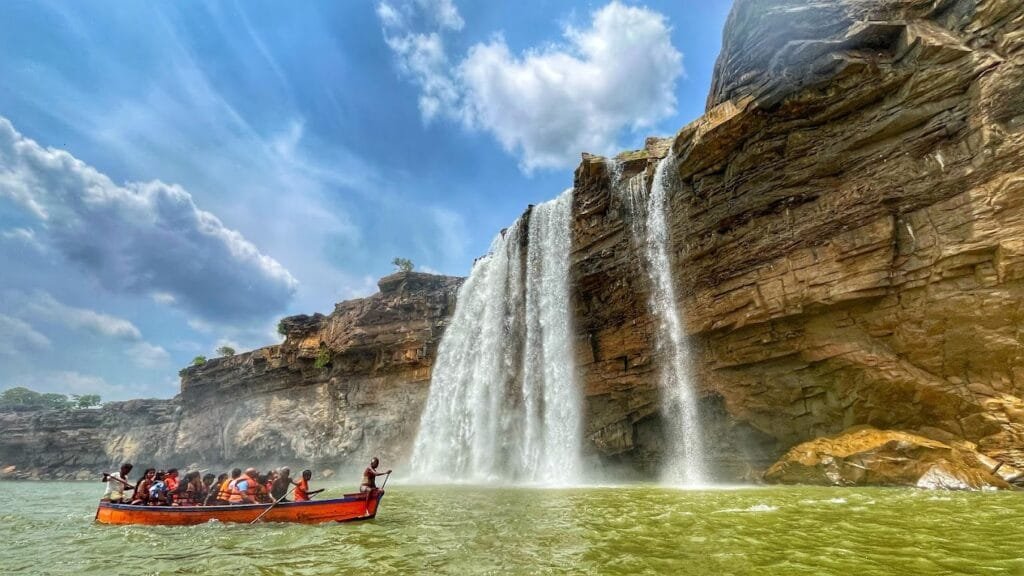
Camping at Tirtha Camp Site: Into the Wild
If you wish to immerse yourself in Bastar’s natural beauty and tribal heritage, head to Tirtha Camp Site, located near the falls. It’s not just camping, it’s a community experience.
What to Expect
The camping experience near Chitrakote Waterfall, especially at the Tirtha Camp Site, is thoughtfully managed by a local self-help group (SHG) under the Bastar Tourism initiatives. This community-led model ensures that tourism benefits the local economy while maintaining a sustainable approach to hospitality. The accommodations include comfortable tents and eco-friendly cottages that blend seamlessly with the natural surroundings.
Visitors can expect clean toilets, essential amenities, and hygienic food services prepared with local ingredients and warmth. The serene environment, paired with the simplicity of the setup, allows guests to disconnect from the chaos of urban life and immerse themselves in nature.
Activities
The camp offers a range of immersive activities that go beyond traditional sightseeing. Evenings come alive around a bonfire with performances of traditional tribal dance and music, where guests are often invited to join in. Nature trails and guided walks along the Indravati riverbank give visitors a chance to explore the local flora, fauna, and scenic beauty of the region.
Stargazing is another highlight—the clear, unpolluted sky of Bastar reveals constellations and celestial wonders not often seen in cities. Guests can also participate in community cooking or watch local cooking demonstrations that showcase the flavors and techniques of tribal cuisine. Storytelling sessions by villagers share the rich myths and legends surrounding Chitrakote waterfall, adding cultural depth to the stay.
Ideal For
This experience is ideal for nature lovers looking to reconnect with the wilderness, cultural tourists seeking authentic interactions with tribal communities, backpackers drawn to offbeat destinations, and students or eco-tourism groups interested in sustainable travel. The blend of adventure, learning, and local engagement makes it a memorable escape for all kinds of travelers.
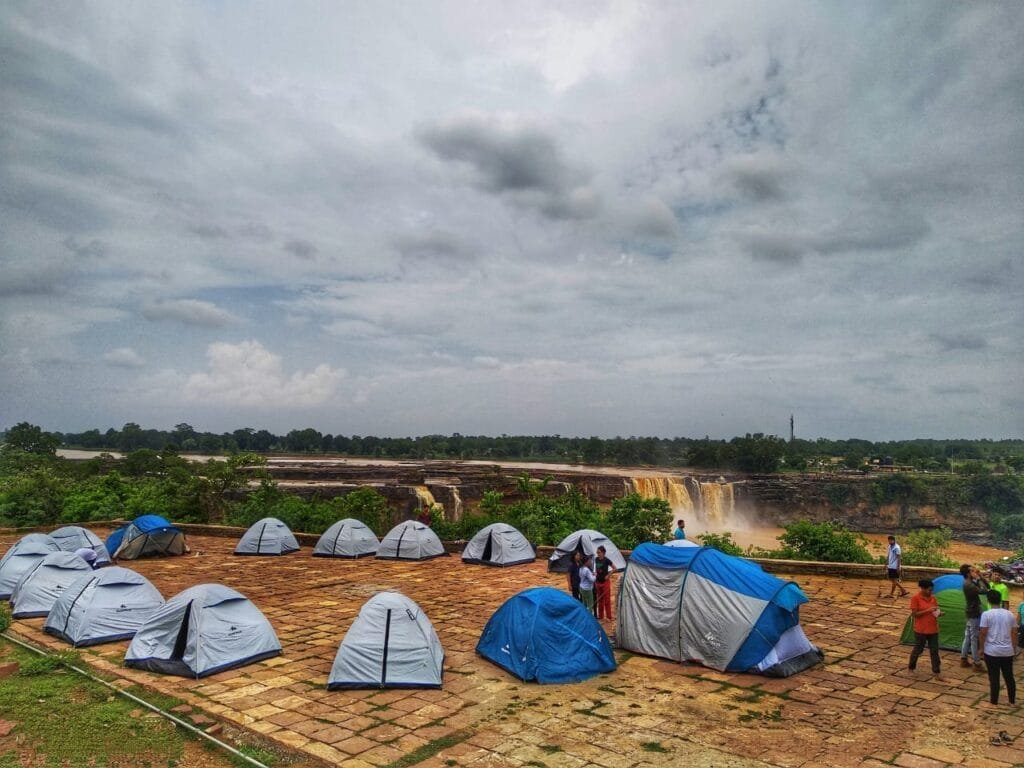
Savoring Local Cuisine: A Tribal Gastronomic Experience
No trip to Chitrakote Waterfall is complete without experiencing the authentic tribal cuisine of Bastar. Influenced by forest produce and tribal traditions, the local food is rustic, organic, and full of character.
Must-Try Dishes:
- Chapda Chutney: A spicy chutney made from red ants—unique to Bastar and considered a delicacy.
- Desi Chicken Curry: Cooked over wood fire using tribal spices.
- Millet Roti and Chana Bhaji: Millets form the staple of Bastar cuisine.
- Mahua Dishes: Mahua flowers are fermented into a local liquor, and also used in sweets and pickles.
- Bamboo Shoot Curry: Forest-fresh bamboo shoots cooked in earthy spices.
- Tamarind chutneys, saag varieties, and tuber-based snacks are common.
You can enjoy these at:
- Local dhabas
- Tribal kitchens at Tirtha Campsite
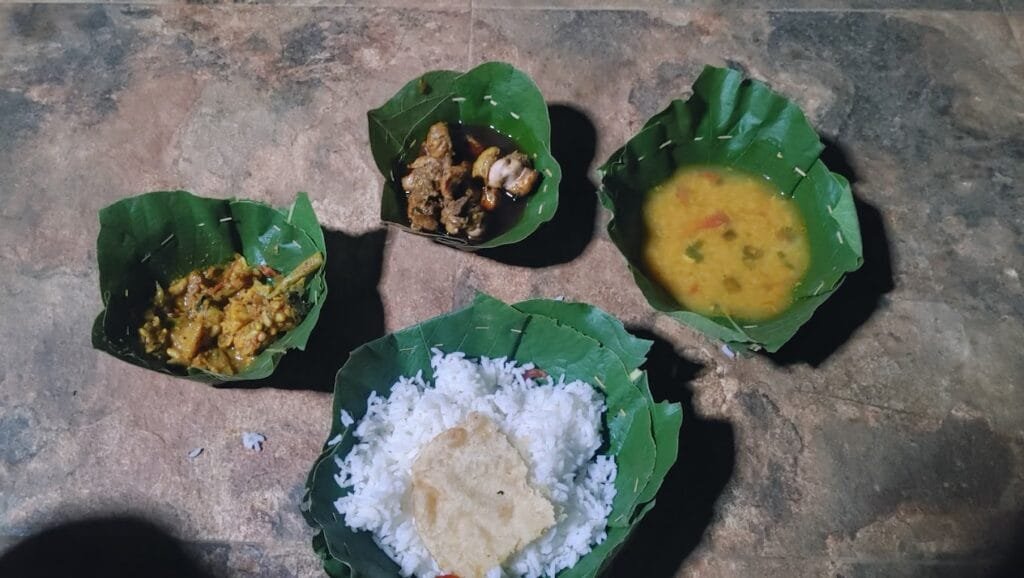
Nearby Attractions and Experiences
Tirathgarh Waterfall
- Another waterfall inside Kanger Valley National Park, about 35 km from Jagdalpur.
- Multi-tiered and falls over laterite rock formations.
- Offers a quiet, offbeat vibe and is less crowded.
Kanger Valley National Park
- A biodiversity hotspot.
- Explore Kotumsar Cave, Kailash Cave, and limestone formations.
- Perfect for birdwatching, jungle treks, and spotting butterflies, leopards, and rare flora.
Bastar Palace
- A historical monument in Jagdalpur, with relics from the Bastar royal family.
- Worth visiting for insights into Bastar’s regal past.
Local Tribal Markets & Fairs
- If your visit coincides with Bastar Dussehra (one of the longest tribal festivals in India), don’t miss the cultural explosion.
- Weekly haats (markets) offer handicrafts, bell metal art, tribal jewelry, and local produce.
Travel Tips for Visiting Chitrakote Waterfall
- Best Time: July–February. Avoid peak monsoon if you’re not comfortable with heavy rains.
- Stay Options: Tirtha Camp Site, forest guesthouses, eco resorts near Chitrakote Waterfall and Jagdalpur.
- Transport:
- Nearest city: Jagdalpur (connected by train and road).
- From Jagdalpur, local taxis or shared autos go to Chitrakote Waterfall.
- Connectivity: Limited mobile network at the falls—ideal for a digital detox!
- Respect Local Culture: Bastar is a tribal heartland. Be mindful of cultural sensitivities and always ask before photographing people.
Conclusion: A Symphony of Water, Culture, and Wilderness
Chitrakote Waterfall is not just a waterfall; it’s a living symphony of roaring waters, dense forests, tribal rhythm, and serene skies. Whether you are a solo traveler, an adventure enthusiast, or a family seeking a unique experience—Chitrakote offers something unforgettable.
From boating beneath a mighty cascade, camping under starlit skies, and tasting red ant chutney, to soaking in tribal culture, Chitrakote Waterfall promises a journey into the raw and beautiful soul of Chhattisgarh.
Read More about Bastar at Bastar Tourist Places
Pre-Booking Enquiry Form
Comment Section
Chitrakote Waterfall: The Niagara of India in Incredible Bastar you should visit in 2025
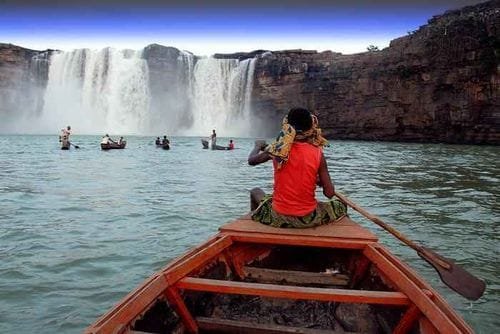
Queries Regarding Bookings
Author Profile
Saurabh Singh
We will love to update the latest updates.



